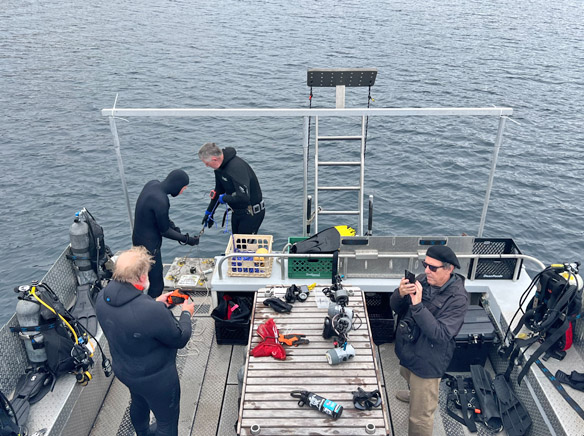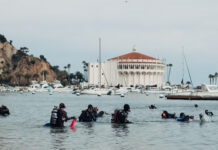
Catalina Marine Society monitoring ocean acidity, other changes
“Think global, act local” is more than a glib environmental catchphrase for members of the Catalina Marine Society (CMS).
The citizen-science non-profit organization recently acted locally to place an underwater instrument platform at Two Harbors that will be used to study the impact of global environmental trends, such as ocean acidification, in the waters around Catalina.
The team of divers, led by current CMS President Mike Doran, sailed to Catalina on the San Pedro-based dive boat Giant Stride on May 23 for the deployment mission. Divers placed the Jim Updike Seabed Station, named for a past CMS president, in 95 feet of water near the USC Wrigley Institute for Environmental Studies in Big Fisherman’s Cove.
The station is designed to accommodate up to nine scientific instruments at a time, supporting a range of local oceanographic research, including CMS projects. CMS publishes its findings in scientific journals and makes the raw data available to researchers studying the marine environment of Catalina and the Southern California Bight.
“As California divers, we’re already seeing changes in our local marine environment firsthand,” said CMS founder and retired aerospace engineer Craig Gelpi. “The data generated by this platform will provide insights into the dynamics of ocean chemistry around Catalina and will assist resource managers in siting future marine protected areas or taking other actions that will mitigate the impact of ocean acidification.”
Unlike other instruments at the Wrigley facility, many of which are mounted on mooring chains, CMS’ station is fixed to the seafloor and will allow accurate measurements of moving phenomena such as currents and tides. The station has a concrete base and brass mounting points, making it non-magnetic, so it can support instruments that incorporate compass measurements.
CMS teams will visit the site periodically to deploy and retrieve instruments. In addition to ocean acidity – a trend CMS has been monitoring elsewhere in Southern California since 2018 – measurements at the seabed station will correlate bottom currents with the tidal swings around the Isthmus.
In addition to Doran, the team that deployed the Seabed Station comprised Capt. Jim Simmerman, longtime Wrigley divers Ted Sharshan, Steve Lang, Chris Glaeser, George Spanos, and CMS board member Jon Davies.
For more information about the CMS and the research it conducts, visit https://www.catalinamarinesociety.org/










